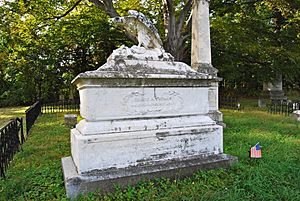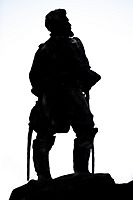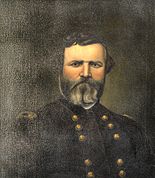George Henry Thomas facts for kids
Quick facts for kids
George Henry Thomas
|
|
|---|---|
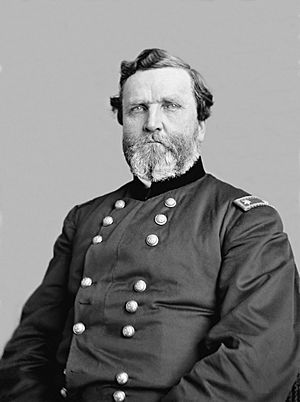 |
|
| Nickname(s) | "Rock of Chickamauga," "Sledge of Nashville," "Slow Trot Thomas," "Old Slow Trot," "Pap" |
| Born | July 31, 1816 Newsom's Depot, Virginia, US |
| Died | March 28, 1870 (aged 53) San Francisco, California, US |
| Buried |
Oakwood Cemetery (Troy, New York)
|
| Allegiance | United States |
| Service/ |
|
| Years of service | 1840–1870 |
| Rank | Major general |
| Commands held | XIV Corps Army of the Cumberland Military Division of the Pacific |
| Battles/wars | |
| Signature | |
George Henry Thomas (July 31, 1816 – March 28, 1870) was an American general who fought for the Union Army during the American Civil War. He was one of the most important commanders in the war's Western Theater.
Thomas fought in the Mexican–American War. When the Civil War began, he chose to stay with the U.S. Army. This was a big decision because he was from Virginia, a state that joined the Confederate States of America.
He won one of the first Union victories at Mill Springs in Kentucky. Later, he played key roles in battles like Perryville and Stones River. His strong defense at the Battle of Chickamauga in 1863 saved the Union Army. This earned him his famous nickname, "the Rock of Chickamauga."
Soon after, he led a major attack at Missionary Ridge during the Battle of Chattanooga. In 1864, he achieved one of the war's most important wins. He destroyed the army of Confederate General John Bell Hood at the Battle of Nashville. Hood had been his student at West Point.
Even though Thomas had a very successful record, he is not as famous as other generals like Ulysses S. Grant or William T. Sherman. He was known as a careful general who did not seek fame. He even turned down promotions if he felt they were not right. After the war, he did not write books about his experiences, which also kept him from being as well-known.
Contents
Early Life and Education
Thomas was born in Newsom's Depot, Southampton County, Virginia. His family lived on a large farm and owned slaves. When George was 13, his father died, causing financial problems for the family.
In 1831, Thomas, his sisters, and his mother had to hide in the woods. This was during Nat Turner's slave rebellion. Some historians believe this event shaped Thomas's views on slavery. He may have seen that slavery could lead to violence. Other historians note he owned slaves for much of his life.
In 1836, Thomas was accepted into the United States Military Academy at West Point, New York. He was 20 years old. He became friends with his roommates, William T. Sherman and Stewart Van Vliet. He did well in his studies and graduated 12th in his class in 1840. He became a second lieutenant in the 3rd U.S. Artillery.
Military Career Before the Civil War
Thomas's first job was in Florida in 1840. He fought in the Seminole Wars, leading his troops in patrols. He was promoted to brevet first lieutenant. From 1842 to 1845, he served in various forts.
When the Mexican–American War began, his regiment moved to Texas. In Mexico, Thomas was a skilled gun commander. He fought bravely at Fort Brown, Resaca de la Palma, Monterrey, and Buena Vista. He earned two more promotions for his actions. At Buena Vista, his commander praised his "coolness and firmness." During this war, Thomas worked closely with Braxton Bragg, who would later be a Confederate general.
In 1851, Thomas returned to West Point. He became an instructor for cavalry and artillery. He worked closely with Lt. Col. Robert E. Lee, who was the Academy's superintendent. Thomas was known as "Slow Trot Thomas" because he was careful not to overwork the horses during training. Some of his students, like J.E.B. Stuart and Fitzhugh Lee, later became famous Confederate cavalry generals.
On November 17, 1852, Thomas married Frances Lucretia Kellogg. In 1854, he was promoted to captain. He was then transferred to California. In 1855, he became a major in the 2nd U.S. Cavalry. This regiment was known for having many Southern officers. Thomas continued his close friendship with Robert E. Lee.
In 1860, Thomas was wounded by an arrow during a fight with a Comanche warrior in Texas. This was his only combat wound in his long career. In November 1860, Thomas took a leave of absence. He met with General Winfield Scott and warned him about a general in Texas who might support the South.
American Civil War
Choosing the Union Side
When the Civil War started, many officers from the South left the U.S. Army. Thomas, being from Virginia, faced a tough choice. He decided to stay loyal to the United States. His family in Virginia was very upset. They turned his picture to the wall and never spoke to him again. Even after the war, they refused money he sent them.
Despite this, some people in the North were still suspicious of him. However, Thomas proved his loyalty. He turned down an offer from the governor of Virginia to join the Confederate army. Union soldiers serving under him grew to like him. They affectionately called him "Pap Thomas."
Early Victories
Thomas was quickly promoted to lieutenant colonel and then colonel in the regular army. He also became a brigadier general of volunteers. His first major assignment was in the Western Theater. In January 1862, he won an important victory at Mill Springs in Kentucky. This was one of the first big Union wins of the war.
He later commanded a large force during the siege of Corinth. He was promoted to major general in April 1862.
Key Battles: Chickamauga and Chattanooga
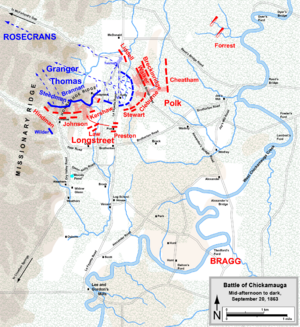
In the fall of 1862, Thomas served as second-in-command at the Battle of Perryville. Later, at the Battle of Stones River, he held the center of the Union line, stopping a Confederate attack.
At the Battle of Chickamauga in September 1863, Thomas commanded the XIV Corps. The Union line on his right collapsed, but Thomas held his position. He gathered scattered Union units on Horseshoe Ridge. He prevented a major Union defeat from becoming a complete disaster. Future President James Garfield visited Thomas during the battle. He reported that Thomas was "standing like a rock." After this battle, Thomas became widely known as "The Rock of Chickamauga."
Thomas then took command of the Army of the Cumberland. This was just before the Battles for Chattanooga in November 1863. These battles were a huge Union victory. Thomas's troops took Lookout Mountain and then stormed Missionary Ridge.
Atlanta and Nashville Campaigns
During General William Tecumseh Sherman's advance through Georgia in 1864, Thomas's army was vital. His staff handled all the supplies and engineering for Sherman's large army. At the Battle of Peachtree Creek in July 1864, Thomas's defense caused heavy damage to Confederate Lt. Gen. John B. Hood's army.
When Hood moved away from Atlanta, Sherman began his famous March to the Sea. Thomas stayed behind to fight Hood in the Franklin-Nashville Campaign. Thomas had a smaller force and raced Hood to Nashville to get reinforcements.
At the Battle of Franklin in November 1864, a part of Thomas's force dealt Hood a strong defeat. This allowed Union forces to gather in Nashville. Thomas needed time to organize his troops, many of whom were new recruits. General Grant, who was in charge of all Union armies, grew impatient. Grant even sent an officer to replace Thomas.
However, Thomas attacked on December 15, 1864. The Battle of Nashville completely destroyed Hood's army in two days. Thomas sent a telegram to his wife saying, "We have whipped the enemy, taken many prisoners and considerable artillery." This victory earned him another nickname: "The Sledge of Nashville."
Later Life and Death
After the Civil War, Thomas commanded military departments in Kentucky and Tennessee. This was during the Reconstruction period. Thomas worked to protect freedmen (formerly enslaved people) from unfair treatment. He used soldiers to stop violence from groups like the Ku Klux Klan.
President Andrew Johnson offered Thomas a promotion to lieutenant general. However, Thomas was loyal and did not want to get involved in politics. He asked the Senate to withdraw his name.
In 1869, Thomas moved to San Francisco to command the Military Division of the Pacific. He died there from a stroke on March 28, 1870. He was writing a response to an article that criticized his military career. None of his family attended his funeral because they had never forgiven him for staying with the Union. He was buried in Oakwood Cemetery in Troy, New York.
Legacy
Veterans of the Army of the Cumberland worked hard to honor Thomas. In 1879, they helped create the statue of Thomas at Thomas Circle in Washington, D.C.
Thomas was the main commander in only two Civil War battles: Mill Springs and Nashville. Both were important victories. His actions at Stones River, Chickamauga, Chattanooga, and Peachtree Creek were also very important. He was known for his smart battle plans and his ability to manage supplies.
Historians generally think highly of Thomas. Many consider him one of the top three Union generals, after Grant and Sherman. However, he is not as well-known. He destroyed his personal papers, saying he did not want his life "hawked in print." Also, most of his campaigns were in the Western Theater, which received less attention.
Grant and Thomas had a somewhat distant relationship. Grant minimized Thomas's contributions in his own memoirs. He called Thomas's movements "always so deliberate and so slow." Sherman also called Thomas "slow" after the war. However, both Grant and Sherman attended Thomas's funeral and were deeply saddened by his death.
Thomas was always on good terms with his commander, William Rosecrans. Even after Rosecrans was replaced by Thomas, he praised him. When Thomas died, Rosecrans called it a "National Calamity."
-
General George H. Thomas' life-size statue in Lebanon, Kentucky.
-
The bronze equestrian statue of Thomas at Thomas Circle in Washington, D.C.
-
Painting of Thomas at Chickamauga and Chattanooga National Military Park.
In Memoriam
A fort near Newport, Kentucky, was named in his honor. The city of Fort Thomas now stands there. A memorial statue of Thomas can be found in Thomas Circle in Washington, D.C.
Thomas's portrait appeared on U.S. paper money in 1890 and 1891. These $5 "treasury notes" are now rare and valuable to collectors.
Thomas County, Kansas, and Thomas County, Nebraska, are both named after him. In 1999, a statue of Thomas was unveiled in Lebanon, Kentucky. A bust of Thomas is also located in Grant's Tomb in Manhattan, New York.
A 10-mile road in Southampton County, Virginia, his birthplace, is named General Thomas Highway.
See also
- List of American Civil War generals (Union)


